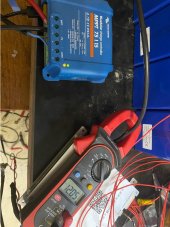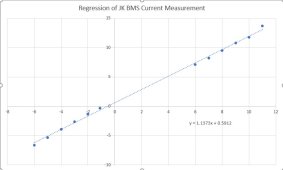Hi All,
I have purchased one of these - if the link doesn't work it's the 8S version of the JK BMS.
What I'm finding is that the current measurement is completely all over the place at low currents - as an example, with a constant, low ripple current power supply pegged at 12 Amps, and balancing turned off, I'm seeing the JK read between mid to low 11 Amps and the mid to high 12 Amps - you can see the video below. I'm confident it's not my power supply as I've tried both an isolated battery powered DC input for my charging and a lab power supply, and both give these wildly fluctuating currents.
In addition, If I use 'calibrate current at, say, 5 Amps, it then has a massive scale error at 10 Amps (reads 15 Amps). In all cases, anything below about 2 Amps reads as zero. The precision also seems to only be about 0.2 of an Amp - so it's like there's a massive quantisation error at low currents.
The balancing current, however, seems to read to three decimal places.
Assuming this current displayed is used to feed the Coulomb Counter I'm not confident it'll be anything more than a random number generator in low current applications.... Other than that I love these BMS's. Has anyone had any experience or success at getting the current readings to behave?
Vid and photo below.

I have purchased one of these - if the link doesn't work it's the 8S version of the JK BMS.
What I'm finding is that the current measurement is completely all over the place at low currents - as an example, with a constant, low ripple current power supply pegged at 12 Amps, and balancing turned off, I'm seeing the JK read between mid to low 11 Amps and the mid to high 12 Amps - you can see the video below. I'm confident it's not my power supply as I've tried both an isolated battery powered DC input for my charging and a lab power supply, and both give these wildly fluctuating currents.
In addition, If I use 'calibrate current at, say, 5 Amps, it then has a massive scale error at 10 Amps (reads 15 Amps). In all cases, anything below about 2 Amps reads as zero. The precision also seems to only be about 0.2 of an Amp - so it's like there's a massive quantisation error at low currents.
The balancing current, however, seems to read to three decimal places.
Assuming this current displayed is used to feed the Coulomb Counter I'm not confident it'll be anything more than a random number generator in low current applications.... Other than that I love these BMS's. Has anyone had any experience or success at getting the current readings to behave?
Vid and photo below.






